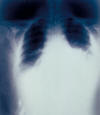Laboratory testing from the
patient’s storage/work facility, his van and his
residence have identified Bacillus anthracis.
These findings are consistent with the hypothesis that
the patient’s exposure occurred while working on
contaminated hides while making traditional drums.
The patient remains hospitalized in
Pennsylvania.
Investigation of other potentially
exposed persons continues; seven persons are currently
on post-exposure prophylaxis for inhalation anthrax.
None of these individuals have symptoms of anthrax. In
addition, surveillance has not identified any other
illness consistent with anthrax disease in NY and PA.
Animal hides pose a low risk of
cutaneous anthrax, and an extremely low risk of
inhalation anthrax. Exotic animal hides may pose a
higher risk for exposure than domestic (U.S.-origin)
hides. The risk of contracting Bacillus anthracis
from handling individual hides is believed to be very
low. The industrial handling of large numbers of hides,
or hair from multiple animals, has historically been
associated with increased risk of anthrax. Among the 236
cases of anthrax reported to CDC from 1955 to 1999, 153
(65%) were associated with industrial handling of animal
hide or hair. Only 9 of the 153 cases (6%) associated
with industrial handling of hair or hide were inhalation
anthrax.
The risk of acquiring anthrax from an
animal hide drum is very low. Of 236 cases of anthrax
reported to CDC from 1955 through 1999, only one case of
cutaneous anthrax was associated with a goat hide bongo
drum purchased in Haiti. No cases of inhalation anthrax
in the US have ever been associated with animal hide
drums. The New York patient’s exposure occurred when he
was making and finishing drums made from untanned animal
hides, and was not associated with playing finished
drums. His exposure was similar to that experienced
during industrial handling of hides, which has been
previously associated with an increased risk of anthrax.
CDC does not currently recommend prophylaxis for persons
who have had contact with animal hide drums. However,
drum owners or players should report any unexplained
febrile illness or unusual skin lesions to their
healthcare provider, and describe their recent contact
with animal hide drums.




